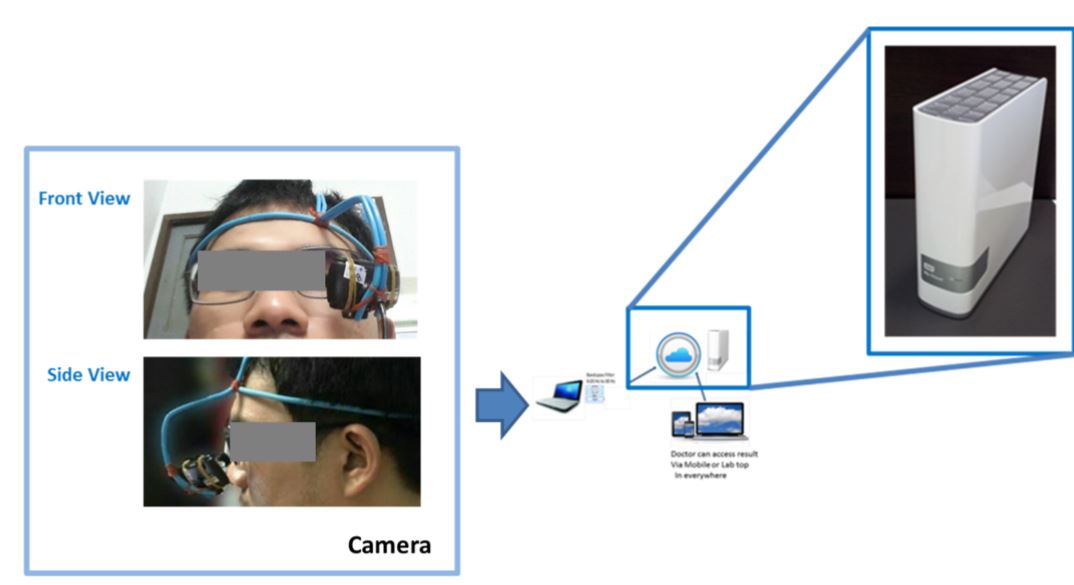iRIS-RT: Eye Fatigue and Reaction Time Detector
Main Article Content
Abstract
The objective of this research is to develop an instrument to measure eye fatigue and reaction time for decision making. The data were automatically analyzed by the iRIS-RT program designed to measure the contraction or expansion of pupils by means of image processing in order to analyze changes of pupil diameters. The image processing technique is a set of images with continuous and different temporal intervals. The images are then transferred into a computer, stored and analyzed to obtain changes of pupil diameters. Pupil diameter of each image in each time interval is measured and frequency of blinking is detected and displayed on the computer screen in an attempt to analyze eye fatigue and to design the assessment of reaction time. The test program is designed with red, green and blue windows that randomly changes according to the set time in order to determine reaction to the colors and accuracy of decision to select the colors that correspond to those on the test program. The test results with the iRIS-RT program among 40 male and female volunteer participants aged between 18 and 35years reveal that the program is able to preliminarily measure and process eye fatigue. Furthermore, it is able to store and record personal results in the computer and Cloud media that are accessible via global online computer and internet systems. The results can be displayed on personal computers and other mobile devices. With regard to satisfaction of the participants with operations of the device, it is found that the satisfaction was at a high level, or 66.7%, and at the highest level, or 33.3%, on the overall efficiency of the device. From interviewing the experts after the construction of the device on its performance, attributes, size, safety, installation and result display, their satisfaction was at a high level.
Article Details
References
SH Bartley, E Chute, “Fatigue and impairment in man”, USA: Mc.Graw–Hill Book Company, pp.156–162, 1947.
B Clayton, V Seema, K Ashbala, et al., “Computervision syndrome: a review survey”, Ophthalmol, vol.50, pp.253–62, 2005.
MJ Dainoff, A Happ and P Crane, “Visual fatigue and occupational stress in VDT operators”, Human Factors, vol 23, no.4, pp.421–438, 1981.
JP De Groot and A Kamphuis, “Eye strain in VDU users : physical correlates and Long–term effects”, Human Factors, vol.24, no.4, pp.409–413, 1983.
DM Eagleman, “How does the timing of neural signals map onto the timing of perception?”, In: Problems of space and time in perception and action (Nijhawan R, ed). Cambridge, UK: Cambridge UP, 2005.
RC Gonzales and RE Woods, Digital Image Processing 3rd. ed. Pearson Education, Inc, 2008.
JE Sheedy, “Vision and work” In: Occupational health and safety. Edited by Ladou J. 2nd ed. USA: National safety council, 1994.
PV Karpovich, Physiology of Muscular Activity W.B.: Suanders Company, Philadelphia, 1962.
R Magaret, The Dynamic of Motor Skill Acquistion. Englewood Cliffs: Prentic-Hall, Inc, Saint Louis, 1972.
LG Shava, Essential of Exercise Physiology, Surjert Publication, Minnessota, 1982.
EC Lee, KR Park, M Whang and KH Min, “Measuring the degree of eyestrain caused by watching LCD and PDP devices”, International Journal of Industrial Ergonomics, vol.39, pp.798–806, 2009.
TH Laubli, W Hunting and E Grandjean, “Postural and visual loads at VDT workplaces II lighting conditions and visual impairment” Ergonomics vol. 24, no.12, pp.933–944, 1981
EC Lee, KR Park, M Whang and KH Min, “Measuring the degree of eyestrain caused by watching LCD and PDP devices”, International Journal of Industrial Ergonomics, vol.39, pp.798–806, 2009.
EC Lee, JW Lee, and KR Park. “Experimental investigations of pupil accommodation factors”, LENS, vol.52, no.9, pp.6478-6485, 2011.
BB Ritchie and JJ Woods, “Changes in Muscle Contractile Properties and Neural Control During Human Muscular Fatigue”, Muscle & Nerve, ol.7, no.9, pp.691-699, 1984.
P Srisooksawat, and A Sootmongkol, “Reaction Time of Men and Women at Difference Age Group”, Journal of Education, vol.15, no.1, pp.57-72, 2013.
AM Rossignal, et al., “Video display terminals use and reported health symptoms among Massachusetts Clerical worker”, Journal of Occupational Medicine, vol.29, no.2, pp.112 –118, 1987.


